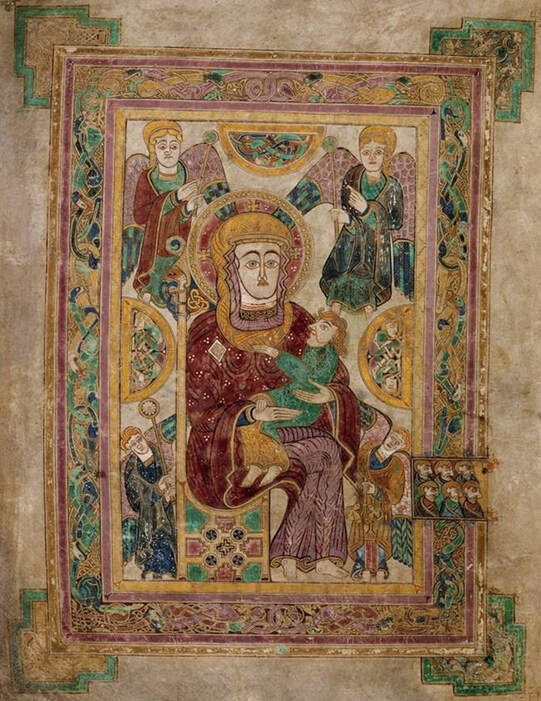|
Rosemary Power describes an image of the Virgin Mary presenting the Christ. Near the start of the Book of Kells, a (Latin) Gospel Book made in about the year 800, most probably on Iona, the island west of the Scottish mainland, comes a portrait of the Virgin and Child (folio 7v). The image is small; within it, Mary is massive, dominating the space within the elaborate frame, crammed as it is with detail. Her pose and her presentation echo the icons of the Eastern Church, and she has a stylised nose and small mouth, with large, almond-shaped eyes and a distant, contemplative gaze. She is seated on a high-backed chair, whose base is decorated with a jewelled cross, and whose back ends in a lion’s head — perhaps indicating that Jesus, Lion of Judah, is supporting her as she holds him in his infancy. She is dressed as a woman of wealth, with the headdress of a Roman matron. The jewelled brooch at her breast adorns garments that were perhaps once purple, and that have the light, clinging sense of silk. Her halo has a decorated rim, and connects to her head through three shining crosses. Jesus is even more stylised: the Lord of creation, as well as the child in her arms. His body is of adult shape, and he has long, wavy hair and a beard-line: it is one of the features of the Book of Kells that he later grows a full beard. The faces, hands, and bare feet of both figures are all whitened — the Northern European way of displaying light as coming from within, comparable to the Eastern way of painting over gold leaf. The figures also have their human aspects. The Eastern models have been adapted to display humanity in Northern Europe: light-coloured hair and blue eyes — something that we have taken as normal, and forgotten that it was once novel. A single curl escapes from Mary’s head-dress. Jesus, his eyes on his mother, dangles his feet and stretches one hand across her breast, while the other clutches her right hand. Both Mary and the angels have legs, and she has breasts with nipples visible through her clothing: she is a nursing mother. Mary holds Jesus protectively, although with her hands — with the palms strangely turned outwards — she offers him to us, the onlookers. The four surrounding angels are full of movement. Two above the head of Mary indicate the scene, and their translucent clothes give a sense of movement, while their wings show through Mary’s transparent halo. The two below peep playfully around her chair. There are half-circle panels on each side, within which two figures have legs entwined as if dancing, perhaps representative of the humanity for whom the incarnation comes about. In another half-circle above are bird-headed creatures with elongated bodies; similar figures interweave within the border. They may be representatives of the heavens, showing — as we find elsewhere in this work with its complex, interconnected imagery — that all creation sings praise of the incarnation. Rosemary Power is a medievalist and writer whose new book Praying with the Book of Kells will be published by Veritas, Dublin, in 2021. This article has been extracted from one published in Church Times (18/25 December 2020) with the author's permission.
1 Comment
Justin Thompson
8/4/2021 10:55:36 pm
"My Soul glorifies the Lord" LUKE: 1:46
Reply
Leave a Reply. |
Categories
All
ForecastSupport UsArchives
July 2024
|

 RSS Feed
RSS Feed
